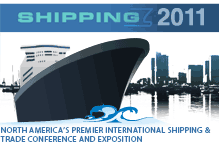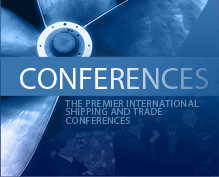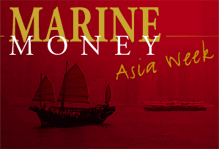
Build It, But Will They Come?
Port Development as a Harbinger of Growth in Shipping and the Gamble Ports are Making
By Alfred J. Kuffler1, Montgomery McCracken Walker & Rhoads
For a very long time, now, the news unrelentingly reports financial disasters – plunging freight rates, collapsing vessel values, failing companies, laid up vessels by the hundreds, and the demise of numerous shipping ventures.
But, though cold comfort to those who have seen the recent economic cycle destroy their fortunes, for the longer term, port development projects already under way and those in the planning stage are based on forecasts of increased trade and therefore substantial growth in ocean transportation.
At least in the United States, a sure sign of long-term growth may be found in port development projects concentrating on container traffic. This segment of the industry accounts for about one third of the waterborne export and imports in the US Deutsche Bank’s RREEF division produced a study in April 2009 cataloguing major port expansion projects in Hampton Roads, Virginia, Savannah, Georgia, Miami, Florida, New Orleans, Houston, Oakland, Tacoma, and Seattle as well as Prince Rupert and Vancouver, British Columbia. The same paper reported industry projections that U.S. west coast container shipments would triple in twenty years. Likewise, the Port of New York and New Jersey is projecting a doubling of container volume by 2020. The writer can add that the Delaware River is witnessing similar development under the aegis of the Philadelphia Regional Port Authority which is overseeing $600 million of development on the Philadelphia side of the river while New Jersey is developing a facility from scratch in Paulsboro.
Containership Size Trends and Lessons from the Airlines
By Peter I. Keller, Peter I. Keller & Associates LLC
The debate over vessel sizing has been intensifying, especially as we consider the expanded capability of the Panama Canal in 2014 and the current order book.
We would venture to say there were many that said the early C4 conversions of Sea-Land that carried 360 35 foot containers were too large and the “jumboized” version of the C4 with 620 boxes was akin to commercial suicide. Today the debate rages on, as carriers now consider the 20,000 TEU threshold, although one can presume it has been virtually crossed with the 18,000 TEU vessels currently on order.
How big is big enough and how big is too big? Within the industry the justification for larger is basically premised upon slot cost economics and the fuel cost per slot. Many argue that the increase in fuel costs outweigh capital costs associated with new, larger vessels. While this makes some sense on the face of the argument, have these carriers also considered the capital costs associated with building larger terminals, bigger cranes and deeper harbors? When considered in its entirety, the costs far exceed the cost of the vessel. Have lines really considered the questions of productivity at terminals and the ability to accumulate and then vacate 8-9,000 individual container units to and from a pier facility in a matter of days? How about the millions and billions for road and rail infrastructure to support dollar savings in cost per container for the vessel and fuel?
Delivering Long-Term Results
By Dudley Holt
As the books close on a year of bankruptcies and restructurings, we should not lose sight that some maritime transportation companies continue to thrive, and for these companies the current market conditions present opportunities for accretive growth. One such company is Kirby Corp, a Houston-based company that has created significant shareholder value. An investor who purchased a share of Kirby 20 years ago would today have an IRR of 15.37% based on the December 16, 2011 closing price of $63.36. Growth through acquisition has been a significant driver, but at the heart of the Company’s success has been a disciplined acquisition strategy and a commitment to maintain a prudent capital structure to handle volatility and survive pro-longed downturns. For insight on how the company has achieved its success, we spoke with Kirby’s CEO, Joe Pyne, who has been with Kirby for more than two decades. His comments were enlightening.
First, for those not familiar with Kirby Corporation, some background: Kirby is publicly listed on the New York Stock Exchange under ticker KEX. The company’s market capitalization was $3.45 billion as of December 14, 2011 is with total revenues of over $1.1 billion in 2010, derived from two business segments. Kirby Marine, which is focused on the transportation of bulk petroleum liquids with tank barges along the US inland and coastal waterways and accounts for 65% of 2011 estimated revenues, and Kirby Engine Systems, focused on diesel engine services and remanufactured parts, and ancillary products, which accounts for 35% of 2011 estimated revenues. Kirby is the largest tank barge operator in the US (by fleet size), and through its diesel engine services segment, the company is the leading after-market service provider for medium and high-speed diesel engines, also acting as a distributor and servicer of high-speed diesel engines and related equipment. In this segment Kirby also manufactures oilfield service equipment, including hydraulic fracturing equipment, for the land-based pressure pumping and oilfield services markets.
Shipping Restructurings: Is Alternative Capital the Solution?
By David Hilty, Bruce McDonald and Gavin Kagan, Houlihan Lokey
Shipping companies are facing headwinds from low day rates and lack of abundant credit from traditional capital sources. This article will review the situation, help identify alternative capital sources and discuss their propensity to invest in the sector.
Where are we now? Day rates are very low and have been so for some time. This has caused certain companies to be confronted by pending liquidity pressure while traditional capital sources such as bank financing and public capital markets are unfortunately not readily available. Numerous shipping companies are therefore seeking alternative sources of capital.
Is Now the Right Time for Opportunistic Shipping Investments?
By Andrew Hampson, Managing Director, Tufton Oceanic Asset Backed Investments
As economic fears increase globally and high profile maritime restructurings are increasingly evident, is the time right for opportunistic investments into shipping assets?
Tufton views the maritime industry as capital intensive, highly cyclical, generally fragmented, specialized and, in the main, has limited access to public capital markets; and this is in “normal” times. In times of distress such as we have experienced over much of the last three years and in particular the last few months, this situation is markedly worse for the industry, due to a lack of traditional bank debt, weak cashflow and strained balance sheets. With increasing pressure on most of our sectors’ lenders (many of whom are European) due to domestic turmoil, political and regulatory pressures and three years of deteriorating portfolios, over the past few months we have seen a sharp upturn in the number of high profile restructurings and forced sales in both the public auction and private second-hand markets. Although there was a similar brief flurry of such activity in late 2008, the current level of activity has not been experienced since the early 1990s.
An Investor’s Perspective on the Shipping Industry
By Wilbur L. Ross, Jr., Chairman & CEO, WL Ross & Co.
Editor’s Note: This is the text and ensuing Q&A from a speech given by Mr. Ross on November 10, 2011 at the Harvard Club in New York in conjunction with a Marine Money forum.
Thank you very much. Nice to have such a stirring eulogy while you are still alive and can enjoy it. Having heard the caution of the prior panel, I now understand why I was scheduled to be here before lunch, because they assumed I’d say at least something upbeat. They’re right, but you probably came here today somewhat curious to learn why our firm has gone into marine transport in a big way.
You already know we’re not Norwegian or Greek in heritage, and don’t even speak either language, and some of you may have heard that I once became seasick on a yacht some years ago. Despite all that, you do know that we invest in distressed companies, so that’s obviously part of the explanation, but there are lots of distressed industries, so why shipping? The 40,000 foot level answer is our belief that internationalization is the most powerful force in the world economy and will continue to cause standards of living to rise in the emerging countries, and in such countries with very low per capita income, rising standards of living basically mean only one thing: increased consumption of commodities, and it is the merchant fleets that haul these commodities as well as the finished goods emerging countries export. Because of this two way commerce between developing and developed countries, world trade consistently grows faster than the world economy, and will propel marine transport growth over the long term.
Chapter 11 – Liberation or Suspended Sentence
By Stephen Drury and Jasel Chauhan, Holman Fenwick Willan
Two thousand eleven has seen the insolvency of several shipping concerns. The boards of companies holding tankers and containerships in particular have watched their earnings decline to a level insufficient to service debt, leaving in prospect but one apparent alternative: wholesale repossession, foreclosure and liquidation.
In many jurisdictions the survival of an enterprise in such circumstances is neither realistic nor possible without the unanimous support of creditors. In the mid 1980s, a time of similar crisis in the shipping industry, there were some bold and dramatic restructurings, having as their ultimate and fortunate result the full payout of the institutions and investors concerned. Those rescues were, however, entirely consensual.
In recent months a number of highly leveraged shipping concerns have turned to another potential survival strategy by making applications to US federal bankruptcy courts for their reorganization under Chapter 11 of the US Bankruptcy Code: including as part of the relief provided the immediate and complete protection from further creditor action. Filings by Omega Navigation (in Houston on 8 July 2011) and Marco Polo Seatrade (in New York on 29 July 2011) have been among the most widely reported instances of this strategy.
CHAPTER 11 – De-mystifying the Process
By Steven B. Soll, Esq., Otterbourg Steindler Houston & Rosen, P.C.
The recent bankruptcy filings by Marco Polo Seatrade B.V., Omega Navigation Enterprises, Inc., General Maritime Corp. and Trailer Bridge Inc. have the industry buzzing about Chapter 11 of the United States Bankruptcy Code. Everyone talks about it, most (whether a potential debtor, lender, investor, contractual counterparty or other type of creditor) resist or fear it, yet few understand the process or how it can affect their business. The purpose of this article is to de-mystify the process by identifying select provisions of the Bankruptcy Code and the Chapter 11 process to provide you with a summary overview of what can happen in a Chapter 11 case.
Chapter 11 is considered to be a debtor friendly process, particularly in comparison to foreign insolvency proceedings, which tend to be more supportive of the strict enforcement of secured and unsecured creditors’ rights. By comparison, the objective of a Chapter 11 proceeding is to provide a debtor with a “fresh start” for the reorganization of its business. Despite this objective, in addition to creditors fearing Chapter 11, debtors resist it as well. Two primary reasons for this trepidation are 1) the high cost of a Chapter 11 case (which will be discussed below) and 2) the uncertainty of the outcome. As they say, you should expect the unexpected.
Dr. Strangelove, or How I Learned To Stop Worrying and Love the Restructuring Process
By Jim Dolphin, Managing Director, AMA Capital Partners
Recent announcements by a growing number of shipowners may not signal the coming of a nuclear winter, but it certainly may feel that way for many shareholders and bondholders – and even first lien banks. During the last big wave of shipping restructurings from 1998 until 2002, when the shipping community had little cash on hand and the bond defaults were coming fast and furious, my partner Peter Shaerf trotted out the line “We thought the market had hit bottom until they started handing out the shovels” as the market cratered quickly and in a very public fashion. This time around, we seem to be in a slow motion wave of defaults, initially concentrated in speculative offshore projects and now gaining pace in commodity shipping markets, where the turnaround seems hard to imagine given the still enormous orderbook. We know there is value locked in these assets, however, so full attention is being turned to restructurings to extract the greatest value – either by acting now or betting on a recovery. Dating back to the late 1990s AMA Capital Partners has been involved as an advisor to companies and creditors in more shipping and offshore restructurings than any other firm, and we have learned a few lessons along the way. Multiple names have been deleted from this piece to protect the innocent, and the not so innocent.
A Guide to Using the Owner’s Manual
By Nora Huvane
Asked to give a presentation on preserving value in difficult capital markets, Mark Whatley, Vice President at Evercore Partners, quipped “perhaps we should first evaluate whether there is any left.”
Fortunately ships do have some intrinsic value, but certain capital structures created during times of much higher values may have run into a negative value situation, which is where Mr. Whatley’s point becomes more apropos. Once the underlying value is disentangled and properly assigned, and losses properly recognized, the “house”, to allude to our cover metaphor, can begin to be restructured and ultimately rebuilt. Liquidity needs and cost tolerances can be accurately assessed, and existing stakeholders can recommit while new investors can also have an opportunity to get in at a time where they stand to make meaningful returns – if they are patient.







